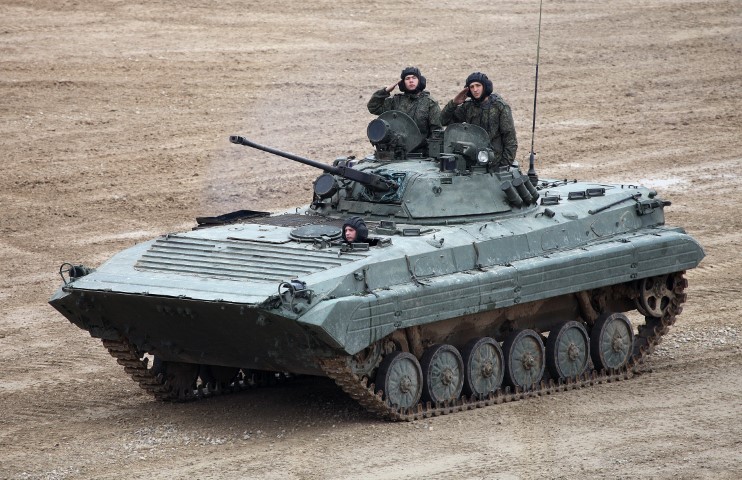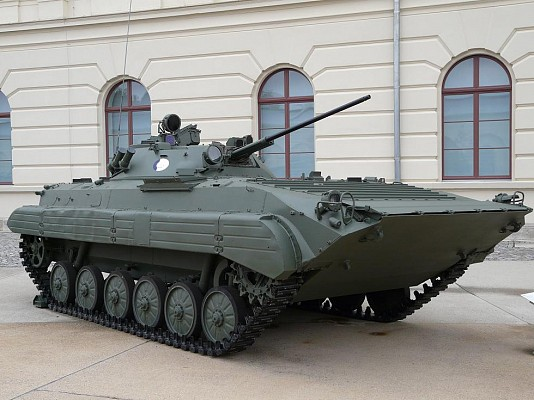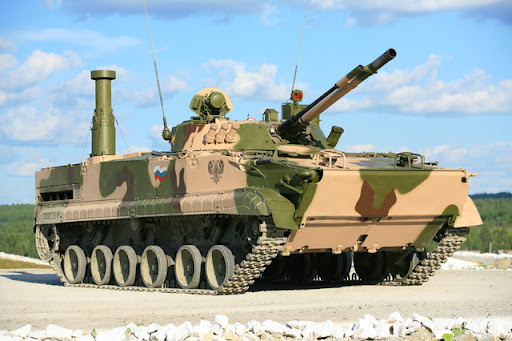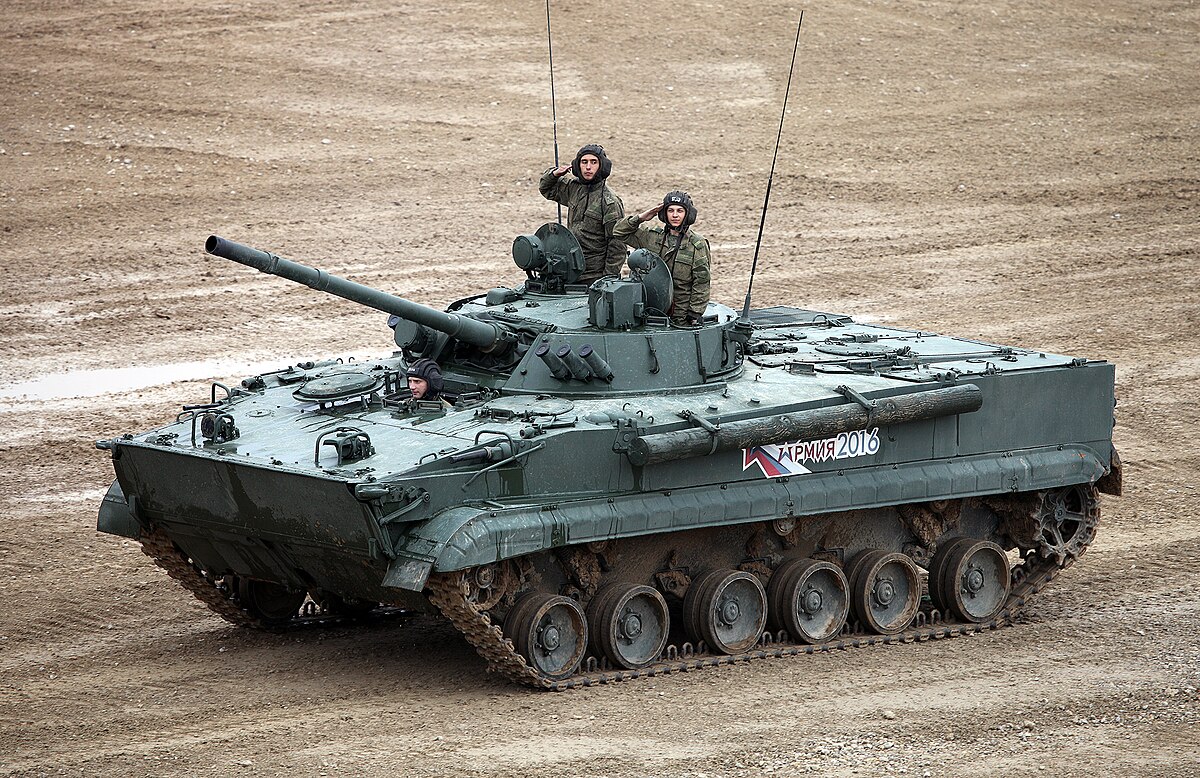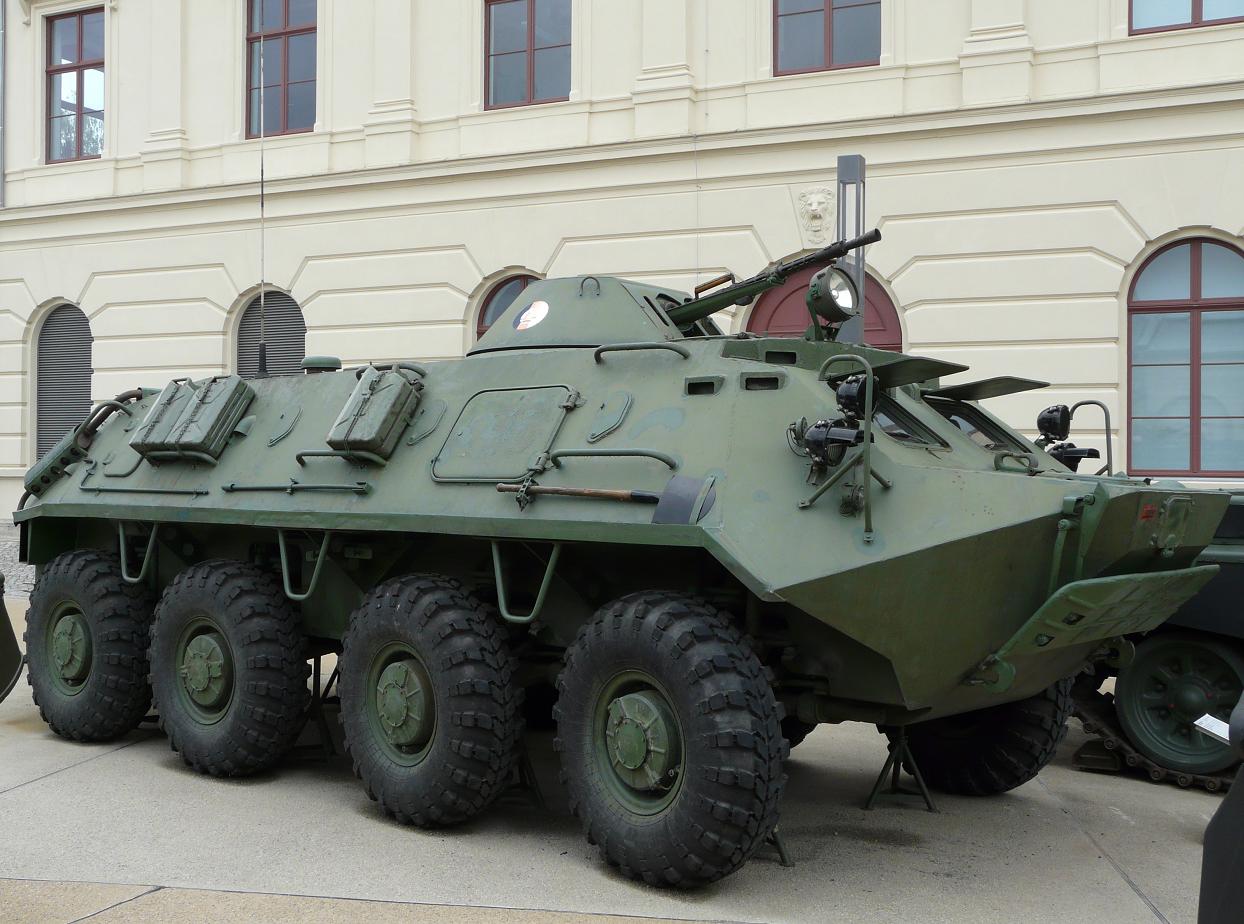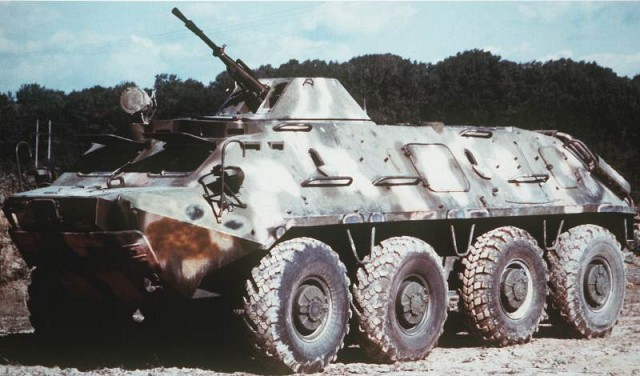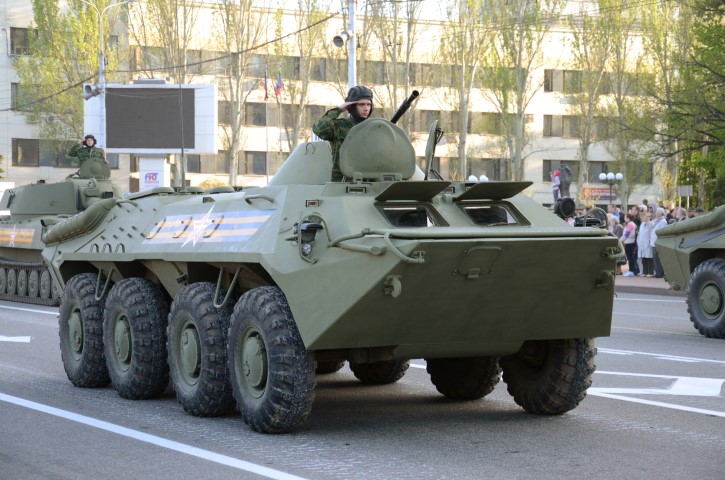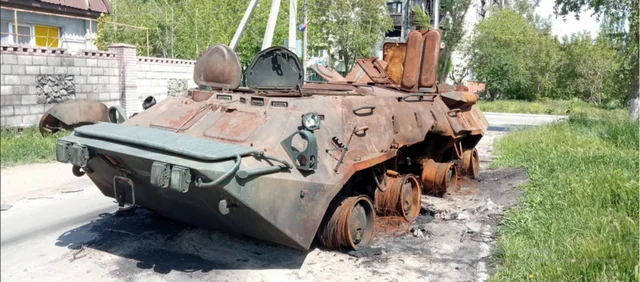This is an old revision of the document!
Table of Contents
APC and IFV Guide (OpFor Factions)
This article is a part of Arma 3 Asset Guides.
The Armored Personnel Carrier (APC) and Infantry Fighting Vehicle (IFV) are two types of armored vehicles designed to transport infantry troops and provide fire support on the battlefield. APCs, such as the M113 and BTR-60, are primarily used to transport troops and equipment, often providing limited armament for self-defense. In contrast, IFVs like the BMP-1 and M2 Bradley are more heavily armed and armored, allowing them to engage enemy forces directly and provide close fire support to dismounted infantry.
| Variants | |
|---|---|
| A | Improved or modified variant |
| BV | Airborne version |
| D | Up-armored |
| K | Komandirskiy, or command version |
BMP-1 Series
The BMP-1 (Боевая Машина Пехоты, Boyevaya Mashina Pekhoty, or Infantry Fighting Vehicle) is a Soviet-designed and produced infantry fighting vehicle that was first introduced in 1966. It was a groundbreaking vehicle at the time, being the world's first mass-produced IFV, and it played a significant role in modernizing the Soviet Army's mechanized infantry capabilities. The BMP-1 was designed to provide a highly mobile and protected platform for infantry units, allowing them to keep pace with armored formations and provide close fire support. It was armed with a 73mm 2A28 smoothbore gun, a 7.62mm PKT machine gun, and could carry a crew of three (commander, gunner, and driver) plus eight infantrymen. The vehicle's armor was relatively thin, with a maximum thickness of 23mm, but it was designed to provide protection against small arms fire and shell splinters. One of the unique features of the BMP-1 is the ability for troops in the rear compartment to fire their personal weapons through firing ports, allowing them to engage targets while still enjoying the protection of the vehicle.
The BMP-1 has undergone several modernization programs and has been produced in various variants, including the BMP-1K (command variant), BMP-1D (desert variant), and BRM-1 (reconnaissance variant). The BMP-1 has also been exported to several countries and has seen action in numerous conflicts, including the Yom Kippur War, the Soviet-Afghan War, and the Iran-Iraq War. The vehicle's design has been modified and improved over the years, with some variants featuring additional armor, improved fire control systems, and enhanced mobility. For example, the BMP-1M variant features a more powerful engine and improved transmission, while the BMP-1KSH features additional communication equipment and a more advanced command and control system. Despite its limitations, the BMP-1 was a significant improvement over earlier infantry fighting vehicles, and it played an important role in the development of modern IFV designs. Over 20,000 BMP-1s were produced, and the vehicle remains in service with several countries around the world, including Russia, China, and India. Its ability to provide a protected and mobile platform for infantry units, combined with its firepower and versatility, make it a valuable asset on the modern battlefield.
BMP-1
| Variant(s) | 🇷🇺 BMP-1, 🇵🇱 BWP-1, 🇸🇰 BVP-1 |
| Description | Soviet-era amphibious infantry fighting vehicle (IFV). |
| Amphibious? | Yes |
| Primary Armament(s) | 73mm 2A28 Grom gun |
| Secondary Armament(s) | 7.62mm PKT machine gun |
| Armor | Welded steel, varying thickness from 6mm to 33mm |
| Countermeasures | Smoke launchers |
| Special Features | Simplistic fire control system, 💧Amphibious |
| Application | IFV, increasingly obsolete; vulnerable to modern anti-tank weapons. |
BMP-1D
| Variant(s) | 🇷🇺 BMP-1D |
| Description | Uparmored BMP-1. |
| Amphibious? | No |
| Primary Armament(s) | 73mm 2A28 Grom gun |
| Secondary Armament(s) | 7.62mm PKT machine gun |
| Armor | Additional appliqué armor on hull and turret. |
| Countermeasures | Smoke launchers |
| Special Features | Simplistic fire control system, no amphibious capability due to armor weight |
| Application | Enhanced protection over the BMP-1 but less amphibious capability. |
BMP-1K
| Variant(s) | 🇷🇺 BMP-1K |
| Description | Command version of the BMP-1. |
| Amphibious? | Yes |
| Primary Armament(s) | Same as BMP-1 |
| Secondary Armament(s) | Same as BMP-1 |
| Armor | Same as BMP-1 |
| Countermeasures | Smoke launchers |
| Special Features | Additional communications equipment, 💧Amphibious |
| Application | Command and control; not designed for frontline combat. |
BMP-1P
| Variant(s) | 🇷🇺 BMP-1P |
| Description | Upgraded BMP-1 with improved armament. |
| Amphibious? | Yes |
| Primary Armament(s) | 73mm 2A28 Grom gun |
| Secondary Armament(s) | 7.62mm PKT machine gun and ATGM launcher |
| Armor | Same as BMP-1 |
| Countermeasures | Smoke launchers, 💧Amphibious |
| Special Features | ATGM capability |
| Application | Improved anti-tank capability over BMP-1. |
BRM-1K
| Variant(s) | 🇷🇺 BMP-1K |
| Description | Armored reconnaissance vehicle based on BMP-1. |
| Amphibious? | Yes |
| Primary Armament(s) | Removed main gun (space for equipment). |
| Secondary Armament(s) | 7.62mm PKT machine gun |
| Armor | Same as BMP-1 |
| Countermeasures | Smoke launchers |
| Special Features | Advanced reconnaissance equipment. |
| Application | Reconnaissance; not a frontline combat vehicle. |
PRP-3
| Variant(s) | 🇷🇺 PRP-3 |
| Description | Artillery reconnaissance vehicle based on BMP-1. |
| Amphibious? | Yes |
| Primary Armament(s) | No main armament. |
| Secondary Armament(s) | 7.62mm PKT machine gun |
| Armor | Same as BMP-1 |
| Countermeasures | Smoke launchers |
| Special Features | Advanced sensors for artillery spotting, 💧Amphibious |
| Application | Artillery reconnaissance. |
BMP-2 Series
The BMP-2 (Боевая Машина Пехоты, Boyevaya Mashina Pekhoty, or Infantry Fighting Vehicle) is a Soviet-designed and produced infantry fighting vehicle that was first introduced in 1980. It was a significant improvement over its predecessor, the BMP-1, and played a crucial role in modernizing the Soviet Army's mechanized infantry capabilities. The BMP-2 was designed to provide a highly mobile and protected platform for infantry units, allowing them to keep pace with armored formations and provide close fire support. It was armed with a 30mm 2A42 autocannon, a 7.62mm PKT machine gun, and could carry a crew of three (commander, gunner, and driver) plus seven infantrymen. The vehicle's armor was thicker than the BMP-1, with a maximum thickness of 33mm, but it was still designed to provide protection against small arms fire and shell splinters.
One of the unique features of the BMP-2 is the ability for the 30mm autocannon to fire a variety of ammunition types, including high-explosive fragmentation rounds, armor-piercing rounds, and smoke rounds. The vehicle also features a more advanced fire control system, including a laser rangefinder and a ballistic computer, which allows for more accurate and effective engagement of targets. The BMP-2 also has the ability for troops in the rear compartment to fire their personal weapons through firing ports, allowing them to engage targets while still enjoying the protection of the vehicle.
The BMP-2 has undergone several modernization programs and has been produced in various variants, including the BMP-2K (command variant), BMP-2M (modernized variant), and BMP-2E (export variant). The BMP-2 has also been exported to several countries and has seen action in numerous conflicts, including the Soviet-Afghan War, the Gulf War, and the Yugoslav Wars. The vehicle's design has been modified and improved over the years, with some variants featuring additional armor, improved fire control systems, and enhanced mobility. For example, the BMP-2M variant features a more powerful engine and improved transmission, while the BMP-2K features additional communication equipment and a more advanced command and control system.
BMP-2 (obr. 1980g.)
| Variant(s) | 🇷🇺 BMP-2 |
| Description | Successor to BMP-1 with enhanced capabilities. |
| Amphibious? | Yes |
| Primary Armament(s) | 30mm 2A42 autocannon |
| Secondary Armament(s) | 7.62mm PKT machine gun and ATGM launcher |
| Armor | Welded steel |
| Countermeasures | Smoke launchers |
| Special Features | Improved fire control system |
| Application | Modernized infantry support and anti-armor roles. |
BMP-2 (obr. 1986g.)
| Variant(s) | 🇷🇺 BMP-2 |
| Description | Updated version of BMP-2 with improvements. |
| Amphibious? | Yes |
| Primary Armament(s) | 30mm 2A42 autocannon |
| Secondary Armament(s) | 7.62mm PKT machine gun and ATGM launcher |
| Armor | Welded steel |
| Countermeasures | Smoke launchers |
| Special Features | Enhanced fire control system and sensors. |
| Application | Similar to BMP-2 (obr. 1980g.) but with minor upgrades. |
BMP-2D
| Variant(s) | 🇷🇺 BMP-2D |
| Description | BMP-2 variant with additional armor. |
| Amphibious? | No |
| Primary Armament(s) | Same as BMP-2 |
| Secondary Armament(s) | Same as BMP-2 |
| Armor | Additional appliqué armor. |
| Countermeasures | Smoke launchers |
| Special Features | Enhanced protection. |
| Application | Improved survivability in combat environments. |
BMP-2K
| Variant(s) | 🇷🇺 BMP-2K |
| Description | Command version of the BMP-2. |
| Amphibious? | Yes |
| Primary Armament(s) | Same as BMP-2 |
| Secondary Armament(s) | Same as BMP-2 |
| Armor | Same as BMP-2 |
| Countermeasures | Smoke launchers |
| Special Features | Additional communications equipment. |
| Application | Command and control. |
BMP-3 Series
The BMP-3 (Боевая Машина Пехоты, Boyevaya Mashina Pekhoty, or Infantry Fighting Vehicle) is a Soviet-designed and produced infantry fighting vehicle that was first introduced in 1990. It was a significant improvement over its predecessors, the BMP-1 and BMP-2, and was designed to provide a highly mobile and protected platform for infantry units in a variety of combat environments. The BMP-3 was armed with a 100mm 2A70 smoothbore gun, a 30mm 2A42 autocannon, and a 7.62mm PKT machine gun, making it one of the most heavily armed infantry fighting vehicles in the world. It could carry a crew of three (commander, gunner, and driver) plus five infantrymen.
The BMP-3 features a unique turret design, with the 100mm gun and autocannon mounted in a single turret, allowing for a high degree of flexibility and firepower. The vehicle's armor is also significantly improved, with a maximum thickness of 35mm, and is designed to provide protection against anti-tank missiles and other advanced threats. The BMP-3 also features a advanced fire control system, including a laser rangefinder, a ballistic computer, and a thermal imaging sight, for accurate and effective engagement of targets at long range.
One of the unique features of the BMP-3 is its ability to fire guided missiles, including the 9M117 Bastion anti-tank missile, which allows it to engage and destroy heavily armored targets. The vehicle also features a rear-mounted engine, which provides a high degree of mobility; enabling the BMP-3 to reach speeds of up to 70 km/h. The BMP-3 also has the ability for troops in the rear compartment to fire their personal weapons through firing ports, allowing them to engage targets while still enjoying the protection of the vehicle.
The BMP-3 has undergone several modernization programs and has been produced in various variants, including the BMP-3M (modernized variant), BMP-3K (command variant), and BMP-3F (amphibious variant). The BMP-3 has been exported to several countries, including Russia, Ukraine, and South Korea, and has seen action in numerous conflicts, including the Gulf War and the War in Afghanistan. The vehicle's design has been modified and improved over the years, with some variants featuring additional armor, improved fire control systems, and enhanced mobility.
Despite its high cost and complexity, the BMP-3 is considered one of the most advanced infantry fighting vehicles in the world, and it plays an important role in the development of modern IFV designs. Over 2,000 BMP-3s have been produced, and the vehicle remains in service with several countries around the world. Its ability to provide a protected and mobile platform for infantry units, combined with its firepower and versatility, make it a valuable asset on the modern battlefield. The BMP-3's advanced fire control system and ability to fire guided missiles make it particularly effective in high-intensity combat environments.
BMP-3
| Variant(s) | 🇷🇺 BMP-3 |
| Description | Advanced IFV with enhanced armor and firepower. |
| Amphibious? | Yes |
| Primary Armament(s) | 100mm gun/missile launcher and 30mm 2A72 autocannon |
| Secondary Armament(s) | 7.62mm PKT machine gun |
| Armor | Aluminum alloy and steel composite, 50mm thickness |
| Countermeasures | Smoke launchers |
| Special Features | Advanced fire control system, multiple armaments. |
| Application | Highly versatile IFV for both infantry support and anti-armor roles. |
BMP-3 (Vesna-K)
| Variant(s) | 🇷🇺 BMP-3 (Vesna-K) |
| Description | BMP-3 variant with improved optics and sensors. |
| Amphibious? | Yes |
| Primary Armament(s) | Same as BMP-3 |
| Secondary Armament(s) | Same as BMP-3 |
| Armor | Same as BMP-3 |
| Countermeasures | Smoke launchers |
| Special Features | Enhanced surveillance and target acquisition. |
| Application | Improved reconnaissance and engagement at longer distances. |
BMP-3 (Vesna-K/A)
| Variant(s) | 🇷🇺 BMP-3 (Vesna-K/A) |
| Description | Further updated version of BMP-3 Vesna-K. |
| Amphibious? | Yes |
| Primary Armament(s) | Same as BMP-3 |
| Secondary Armament(s) | Same as BMP-3 |
| Armor | Same as BMP-3 |
| Countermeasures | Smoke launchers |
| Special Features | More advanced optics and electronic systems. |
| Application | Enhanced capabilities over BMP-3 Vesna-K. |
Obyekt-681-2
| Variant(s) | 🇷🇺 Obyekt-681-2 |
| Description | Experimental BMP variant. |
| Amphibious? | Yes |
| Primary Armament(s) | Not specifically known, could have had similar armament to BMP series. |
| Secondary Armament(s) | Not specified. |
| Armor | Not specified. |
| Countermeasures | Likely smoke launchers. |
| Special Features | Not widely documented. |
| Application | Experimental design; exact details limited. |
BTR-60 Series
The BTR-60 (Бронетранспортер, Bronetransporter, or Armored Transporter) is a Soviet-designed and produced armored personnel carrier that was first introduced in 1961. It was a significant improvement over earlier APC designs, and played a crucial role in modernizing the Soviet Army's mechanized infantry capabilities. The BTR-60 was designed to provide a highly mobile and protected platform for infantry units, allowing them to keep pace with armored formations and provide close support. It was armed with a 7.62mm SGMB machine gun and could carry a crew of two (commander and driver) plus 12 infantrymen. The vehicle's armor was relatively thin, with a maximum thickness of 9mm, but it was still designed to provide protection against small arms fire and shell splinters.
One of the unique features of the BTR-60 is its amphibious capability, allowing it to cross rivers and other bodies of water with ease. The vehicle also features a simple and reliable design, making it easy to maintain and operate in the field. The BTR-60 has undergone several modernization programs and has been produced in various variants, including the BTR-60P (initial production variant), BTR-60PA (variant with a more powerful engine), and BTR-60PB (variant with improved armor and armament). The BTR-60 has also been exported to several countries and has seen action in numerous conflicts, including the Soviet-Afghan War and the Yugoslav Wars.
The BTR-60 has been modified and improved over the years, with some variants featuring additional armor, improved communication equipment, and enhanced mobility. For example, the BTR-60PB variant features a more powerful engine and improved transmission, while the BTR-60PA variant features additional armor plating and a more advanced machine gun mount. Despite its limitations, the BTR-60 was a significant improvement over earlier APC designs, and it played an important role in the development of modern APC designs. Over 25,000 BTR-60s were produced, and the vehicle remains in service with several countries around the world, including Russia, Ukraine, and India. Its ability to provide a protected and mobile platform for infantry units, combined with its amphibious capability and reliability, make it a valuable asset on the modern battlefield.
BTR-60
| Variant(s) | 🇷🇺 BTR-60 |
| Description | Eight-wheeled amphibious armored personnel carrier (APC) of the Soviet era. |
| Amphibious? | Yes |
| Primary Armament(s) | 14.5mm KPVT heavy machine gun |
| Secondary Armament(s) | 7.62mm PKT machine gun |
| Armor | Welded steel, 7mm to 10mm thickness. |
| Countermeasures | None |
| Special Features | Dual gasoline engines, 💧Amphibious |
| Application | Troop transport in various terrains; outdated and vulnerable to modern anti-armor threats. |
BTR-70 Series
The BTR-70 (Бронетранспортер, Bronetransporter, or Armored Transporter) is a Soviet-designed and produced armored personnel carrier that was first introduced in 1972. It was a significant improvement over its predecessor, the BTR-60, and played a crucial role in modernizing the Soviet Army's mechanized infantry capabilities. The BTR-70 was designed to provide a highly mobile and protected platform for infantry units, allowing them to keep pace with armored formations and provide close support. It was armed with a 7.62mm PKT machine gun and could carry a crew of three (commander, gunner, and driver) plus nine infantrymen. The vehicle's armor was thicker than the BTR-60, with a maximum thickness of 16mm, but it was still designed to provide protection against small arms fire and shell splinters.
One of the unique features of the BTR-70 is its improved mobility, thanks to its more powerful engine and improved transmission. The vehicle also features a more advanced fire control system, including a telescopic sight and a more accurate machine gun mount. The BTR-70 has undergone several modernization programs and has been produced in various variants, including the BTR-70 (initial production variant), BTR-70M (modernized variant), and BTR-70Di (variant with improved armor and armament). The BTR-70 has also been exported to several countries and has seen action in numerous conflicts, including the Soviet-Afghan War and the Yugoslav Wars.
The BTR-70 has been modified and improved over the years, with some variants featuring additional armor, improved communication equipment, and enhanced mobility. For example, the BTR-70M variant features a more powerful engine and improved transmission, while the BTR-70Di variant features additional armor plating and a more advanced machine gun mount. Despite its limitations, the BTR-70 was a significant improvement over earlier APC designs, and it played an important role in the development of modern APC designs. Over 13,000 BTR-70s were produced, and the vehicle remains in service with several countries around the world, including Russia, Ukraine, and India. Its ability to provide a protected and mobile platform for infantry units, combined with its improved mobility and firepower, make it a valuable asset on the modern battlefield.
BTR-70
| Variant(s) | 🇷🇺 BTR-70 |
| Description | Eight-wheeled amphibious APC, successor to the BTR-60. |
| Amphibious? | Yes |
| Primary Armament(s) | 14.5mm KPVT heavy machine gun |
| Secondary Armament(s) | 7.62mm PKT machine gun |
| Armor | Welded steel, 9mm to 20mm thickness. |
| Countermeasures | Smoke grenade launchers |
| Special Features | Dual gasoline engines, 💧Amphibious |
| Application | Enhanced troop transport; more protected than BTR-60 but still vulnerable to contemporary threats. |
BTR-80 Series
The BTR-80 (Бронетранспортер, Bronetransporter, or Armored Transporter) is a Soviet-designed and produced armored personnel carrier that was first introduced in 1984. It was a significant improvement over its predecessors, the BTR-60 and BTR-70, and played a crucial role in modernizing the Soviet Army's mechanized infantry capabilities. The BTR-80 was designed to provide a highly mobile and protected platform for infantry units, allowing them to keep pace with armored formations and provide close support. It was armed with a 14.5mm KPVT machine gun and could carry a crew of three (commander, gunner, and driver) plus seven infantrymen. The vehicle's armor was thicker than the BTR-70, with a maximum thickness of 23mm, but it was still designed to provide protection against small arms fire and shell splinters.
One of the unique features of the BTR-80 is its improved armor, which provides better protection against anti-tank missiles and other modern threats. The vehicle also features a more advanced fire control system, including a telescopic sight and a more accurate machine gun mount. The BTR-80 has undergone several modernization programs and has been produced in various variants, including the BTR-80 (initial production variant), BTR-80A (variant with improved armor and armament), and BTR-80S (variant with improved mobility and communication equipment). The BTR-80 has also been exported to several countries and has seen action in numerous conflicts, including the Soviet-Afghan War, the Gulf War, and the Yugoslav Wars.
The BTR-80 has been modified and improved over the years, with some variants featuring additional armor, improved communication equipment, and enhanced mobility. For example, the BTR-80A variant features a more powerful engine and improved transmission, while the BTR-80S variant features additional armor plating and a more advanced machine gun mount. Despite its limitations, the BTR-80 was a significant improvement over earlier APC designs, and it played an important role in the development of modern APC designs. Over 5,000 BTR-80s were produced, and the vehicle remains in service with several countries around the world, including Russia, Ukraine, and India. Its ability to provide a protected and mobile platform for infantry units, combined with its improved armor and firepower, make it a valuable asset on the modern battlefield.
BTR-80
| Variant(s) | 🇷🇺 BTR-80 |
| Description | Eight-wheeled amphibious APC, improved version of the BTR-70. |
| Amphibious? | Yes |
| Primary Armament(s) | 14.5mm KPVT heavy machine gun |
| Secondary Armament(s) | 7.62mm PKT machine gun |
| Armor | Welded steel, 10mm to 20mm thickness. |
| Countermeasures | Smoke grenade launchers |
| Special Features | Single diesel engine; enhanced ergonomics and internal layout, 💧Amphibious |
| Application | Modern troop transport with improved mobility and protection over predecessors. |
BTR-80A
| Variant(s) | 🇷🇺 BTR-80A |
| Description | Modernized variant of the BTR-80 with enhanced firepower. |
| Amphibious? | Yes |
| Primary Armament(s) | 30mm 2A72 autocannon |
| Secondary Armament(s) | 7.62mm PKT machine gun |
| Armor | Welded steel, 10mm to 20mm thickness. |
| Countermeasures | Smoke grenade launchers |
| Special Features | 💧Amphibious |
| Application | Troop transport with significantly improved engagement capabilities against infantry and light vehicles. |
PTS-M
| Variant(s) | 🇷🇺 PTS-M |
| Description | Tracked amphibious transport vehicle designed primarily for transporting troops and cargo across water bodies. |
| Amphibious? | Yes |
| Primary Armament(s) | None (intended as a transport vehicle) |
| Secondary Armament(s) | None |
| Armor | Light steel, primarily for protection against small arms fire. |
| Countermeasures | None |
| Special Features | 💧Amphibious |
| Application | Primarily for river crossings and amphibious landings, not designed for direct combat. |


